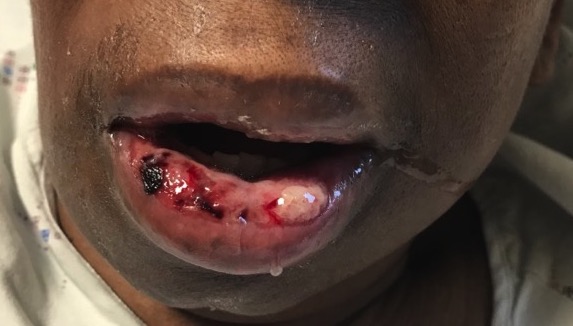May 2020 Case Study
A 68-year-old female with history of diabetes, hypertension, and rheumatoid arthritis is seen in clinic for a two-week history of oral ulcers. She is experiencing exquisite pain that is impeding her ability to eat and drink. She believes the dose of one of her medications has recently changed but she cannot recall the name of the medication. She is up to date on all age-appropriate cancer screenings and denies fevers, weight loss, or night sweats. On exam, there are erosions and ulcers of the lower mucosal lip with overlying hemorrhagic crust and edema. No other cutaneous findings are noted. Laboratory values reveal pancytopenia with neutropenia.
Based on history and clinical presentation, which of the following medications is most likely the cause of findings?
A.) Furosemide
B.) Metformin
C.) Amlodipine
D.) Methotrexate
E.) Lisinopril
Correct Answer: D.) Lisinopril
Methotrexate is a commonly prescribed therapy by dermatologists as well as rheumatologists and oncologists. It is a folic acid antagonist that competitively inhibits dihydrofolate reductase resulting in decreased folic acid synthesis.1. Reduced folic acid synthesis subsequently reduces DNA synthesis.1 Due to the effect on folic acid synthesis, it is important to supplement folic acid while receiving methotrexate therapy. Dosed weekly, methotrexate has been shown to be efficacious in management of psoriasis, atopic dermatitis, and many other dermatologic conditions.2 However, simplistic dosing does not preclude from potential side effects.
The most severe side effects include pancytopenia and hepatotoxitcity. Pancytopenia and elevated liver enzymes are often identified early in treatment or in the setting of acute methotrexate toxicity.1 Conversely, hepatic fibrosis is a rare long-term side effect that should be investigated with liver ultrasound (Fibroscan) or liver biopsy after cumulative dose of 3.0 to 4.5 grams.1,3 In the event of methotrexate toxicity, as described in this case, clinical findings include pancytopenia, mucocutaneous ulcerations, and transaminitis. If clinical suspicion for toxicity is high, folinic acid should be administered as rescue therapy. Pancytopenia should be monitored and typically reaches its nadir 7 to 10 days after the last dose.4 Approach to treatment of mucositis should focus on supportive care.
Prescribers of methotrexate must be aware of several significant drug interactions. Severe myelosuppression can result from concomitant use of other folate antagonists, such as trimethoprim, sulfonamides, and dapsone.1,2 Additionally, NSAIDs, salicylates, tetracyclines, and loop diuretics can increase the serum concentration of methotrexate, which may result in acute toxicity.1 Use of alcohol or systemic retinoids while receiving methotrexate therapy can increase risk of hepatic injury or accelerate development of hepatic fibrosis.1 Ultimately, appropriate counseling on avoidance of particular medications and informing other healthcare providers of methotrexate use are imperative to patient safety.
Adverse reactions of the remaining answer choices do not commonly include mucositis with pancytopenia. Lisinopril is an antihypertensive that has been associated with angioedema and drug-induced subacute cutaneous lupus erythematosus.2 Furosemide is a loop diuretic that is associated with drug-induced bullous pemphigoid and pseudoporphyria.2 The calcium channel blocker amlodipine is primarily used as an antihypertensive but can also treat Raynaud’s phenomenon. Dermatologic side effects of amlodipine include gingival hyperplasia, drug reaction with eosinophilia and systemic symptoms, and, less commonly, granuloma annulare.2 Metformin is an oral antihyperglycemic that is well known for gastrointestinal side effects rather than cutaneous or hematologic side effects.
References
- Wolverton SE. Comprehensive Dermatologic Drug Therapy, 4td ed. Philadelphia. Elsevier.
- Bolognia JL, Schaffer JV, Cerroni L. Dermatology. 4th ed. Philadelphia. Elsevier Limited.
- Kalb RE, Strober B, Weinstein G, Lebwohl M. Methotrexate and psoriasis. 2009 National Psoriasis Foundation consensus conference. J Am Acad Dermatol. 2009;60: 824-837.
- Knoll K, Anzengruber F, Cozzio A, et al. Mucocutaneous ulcerations and pancytopenia due to methotrexate overdose. Case Rep Dermatol. 2016 Sep-Dec; 8(3): 287–293.


